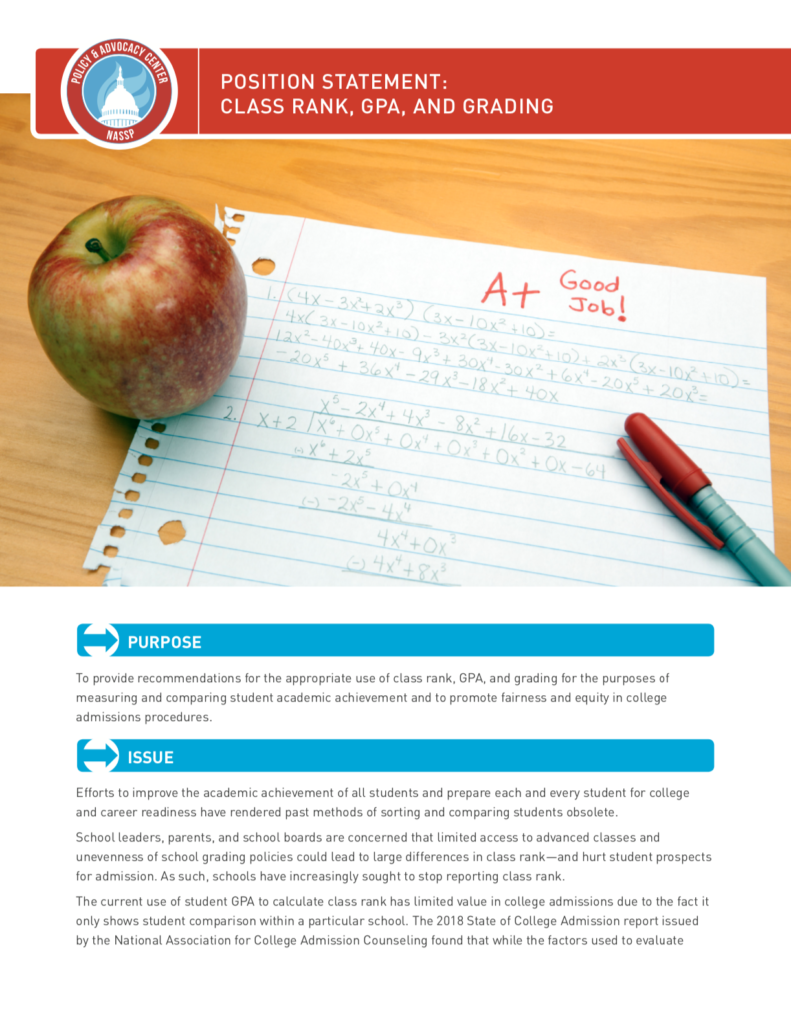Class Rank, GPA, and Grading
To provide recommendations for the appropriate use of class rank, GPA, and grading for the purposes of measuring and comparing student academic achievement and to promote fairness and equity in college admissions procedures.
Efforts to improve the academic achievement of all students and prepare each and every student for college and career readiness have rendered past methods of sorting and comparing students obsolete.
School leaders, parents, and school boards are concerned that limited access to advanced classes and unevenness of school grading policies could lead to large differences in class rank—and hurt student prospects for admission. As such, schools have increasingly sought to stop reporting class rank.
The current use of student GPA to calculate class rank has limited value in college admissions due to the fact it only shows student comparison within a particular school. The 2018 State of College Admission report issued by the National Association for College Admission Counseling found that while the factors used to evaluate applications have remained fairly consistent for 20 years, class rank has been declining in importance. In fact, only 1 in 3 admissions counselors identified class rank as even moderately important in the admissions process.
Colleges and universities have responded by developing their own systems of ranking students and calculating projected class ranks. In addition, a number of universities recalculate student GPA by either adding or removing weighting to college-level courses or calculating GPA based solely on core academic courses.
Currently, however, there are conflicting trends concerning how class rank is reported. As schools and districts moved to eliminate class rank and sought to increase the number of students admitted to competitive state colleges and universities, some state lawmakers—most notably in Texas and California—passed statutes requiring that students be admitted to state universities on the basis of class rank. These statutes reflect a desire to increase the diversity of students who attend state universities and to open enrollment at state universities to a wider range of individual schools across a state.
For example, about 70 percent of the students at the University of Texas at Austin were granted admission based on their class rank in 2016. Under that state admissions policy, the number of different high schools within the state sending students to the University of Texas has also risen dramatically. Previously, students from low-performing, high-poverty, mostly urban schools had difficulty gaining admission to competitive universities. It appears that using class rank as one factor for admission to competitive colleges does increase diversity and results in a wider range of high schools sending students to those universities.
Guiding Principles
- Schools should hold high expectations and promote academic excellence for each student, not a select few.
- Each student should graduate from high school with the knowledge and skills to help them succeed in college, career, and life.
- To be able to prosper in an interdependent world, each student should acquire a body of essential knowledge and skills, including literacy and math skills. To this end, schools should encourage students to assume a well-rounded, rigorous, and challenging course of study that helps them to be global citizens.
- High-quality standards and assessments with valid comparisons of student progress should measure what students know and are able to do—and enable valid comparisons between students in different schools across the country.
- Schools should encourage and recognize academic excellence in a spirit of cooperation, not intense competition that sets one student against another.
- Grading policies should directly impact the delivery of instruction.
- School leaders should implement the Building Ranks™ framework for school leadership to help them build and sustain a healthy culture and lead learning within their specific communities that will prepare each child for success in college, citizenship, career, and life.
Recommendations
When making decisions regarding grading, GPA, and the use of class rank, school leaders should take into consideration the context in which their school operates—including state laws, college and university admission requirements, community attitudes, and what best meets the needs of the students.
Grading
- Grades should be an accurate measure of course mastery and what students know and are able to do, which will help teachers give students and parents feedback on what academic areas need improvement.
- Grading practices should encourage and motivate each student to take rigorous courses and should not be punitive in nature.
- Particular attention should be paid to grading practices related to behavioral issues and homework—which should be viewed as independent practice.
- Students learn at different rates and should be given the time and assistance they need to master course content.
GPA
School policies and practices relating to the formulation of a student GPA should:
- Include all courses completed by the student
- Comprise all high school-level courses including those taken while attending a middle level school (examples would include algebra and world language courses)
- Be an accurate reflection of academic rigor
- Contribute to a valid comparison of class rank
- Include provisions for transfer students
Weighting
When considering the weighting of grades, schools should ensure that:
- All students are encouraged to take a more rigorous course of study and be appropriately recognized for doing so.
- Weighted grades are not used to sort students and determine who receives recognition.
- Students are not discouraged from taking nonweighted courses.
- Weighting of course grades should be applied only to externally moderated courses such as AP, IB, or dual-enrollment courses in which it is possible to ensure the content and quality of course content between schools and among individual teachers.
- The decision to weight grades should be accompanied by open enrollment policies in all externally moderated courses including AP, IB, and dual-enrollment courses. The failure to do so:
- Stratifies student opportunity
- Represents a new form of tracking
- Creates competition for scarce resources
- Disadvantages schools that are able to offer few AP or IB courses
- Students receiving weighted credit should be required to complete the course and to complete the summative assessment.
Class Rank
- A system of class rank should not carry an underlying assumption that academic success is a scarce commodity available only to a select few students. Class rankings should only occur if the recommendations above for grading, GPA, and weighting are in place.
- Class rank should be cumulative. The rank should include all courses taken by the student and not be limited to a select few core courses. In addition, class rankings should include all students within a given class.
- The system of calculating class rank should allow students to improve through persistence and hard work.
- Alternatives to reporting class rank include but are not limited to the following:
- Grade distribution of the class including the range and median GPA
- Estimated rank
- Ranking of core courses only
- Reporting of AP results
- Latin honor system, which requires a specific GPA to graduate cum laude, magna cum laude, or summa cum laude
Resources
Attewell, P. (2001, October). The winner-take-all high school: Organizational adaptations to educational stratification. ProQuest Education Journals, 74(4), 267–295.
Balingit, M. (2015, July). High schools are doing away with class rank. What does that mean for college admissions? The Washington Post. Retrieved from https://www.washingtonpost.com/news/grade-point/wp/2015/07/13/high-schools-are-doing-away-with-class-rank-what-does-that-mean-for-college-admissions/?noredirect=on&utm_term=.92d4aceaf752
Bracey, G. W. (2002, May). Stratification among the haves. Phi Delta Kappan, 83(9). 656–57.
Clinedinst, M., & Patel, P. (2018). 2018 State of College Admission. National Association for College Admission Counseling. Retrieved from https://www.nacacnet.org/globalassets/documents/publications/research/2018_soca/soca18.pdf
Cognard, A. M. (1996). The case of weighting grades and waiving classes for gifted and talented high school students. (ED429290). Storrs, CT: National Resource Center on the Gifted and Talented, University of Connecticut.
Cohn, E., Cohn, S., Balch, D., & Bradley, J. (2004, December). Determinants of undergraduate GPAs: SAT scores, high-school GPA and high-school rank. Economics of Education Review, 23(6), 577–586.
Doggett, M. (1988, April). Higher standards, new incentives: Justice for valedictorians. NASSP Bulletin, 53–56.
Espenshade, T., Hale, L, & Chung, C. (2005). The frog pond revisited: High school academic context, class rank, and elite college admission. ProQuest Education Journals, 78(4) 269–293.
Feldman, J. (2018). School grading policies are failing children. Retrieved from https://crescendoedgroup.org/wp-content/uploads/2018/10/Call-to-Action-for-Equitable-Grading-Oct-2018.pdf
Ferkenhoff, E. (2006, July 10). How schools are pulling rank. Time. Retrieved from http://www.time.com/time/printout/0,8816,1212168,00.html
Finder, A. (2006, May 5). Schools avoid class ranking, vexing colleges. The New York Times. Retrieved from https://www.nytimes.com/2006/03/05/education/05rank.html
Fischer, K. (2005). Class-rank plan faces trouble in Texas. The Chronicle of High Education, 51(33), A25. Retrieved from http://proquest.umi.com/pqdweb?index=0&did=844366251
Gewertz, C. (2008, October 1). Texas move to tighten GPA formula sparks backlash: Some fear proposal would discourage students from taking rigorous classes. Education Week.
Gilman, D., & Swan, E. (1989, March). Solving G.P.A. and class rank problems. NASSP bulletin, 91–97.
Guskey, T. (2014, March 28). Class rank weighs down true learning. Education Week. Retrieved from https://www.edweek.org/ew/articles/2014/03/01/kappan_guskey.html
Hanover Research. (2011). Effective grading practices in the middle school and high school environments. Retrieved from https://njctl-media.s3.amazonaws.com/uploads/Effective%20grading%20practices%20in%20the%20middle%20school%20and%20high%20school%20environments.pdf
Hebel, S. (2003). “Percent plans” don’t add up. Chronicle of Higher Education. 49(28), A22–A26.
Imber, J. (2002). The problem with grading. American School Board Journal. 189(6). 40–41, 47.
Kuncel, N. R., Crede, M., & Thomas, L. L. (2005, Spring). The validity of self-reported grade point averages, class ranks, and test scores: A meta-analysis and review of the literature. Review of Educational Research, 75(1), 63–82.
Lang, D. (2007, Spring). Class rank, GPA, and valedictorians: How high schools rank students. American Secondary Education, 35(2), 36–48.
Lang, D. M. (1997, Summer). Accurate and fair class ranks: One step closer with the class rank index. ERS Spectrum. 15(3), 26–29.
Levy, J., & Riordan, P. (1994). Rank-in-class, grade point average, and college admissions. (ED370988). Reston, VA: National Association of Secondary School Principals.
Lockhart, E. (1990, Winter). Heavy grades? A study on weighted grades. Journal of College Admissions, 126, 9–16.
Mitchell, B. M. (1994). Weighted grades. Gifted Child Today, 17(4). 28–29.
Moss, D. (2002). When more is less: High school music and class rank. ProQuest Education Journals, 2(6), 6–7.
National Association of Secondary School Principals (2018). Building ranks: A comprehensive framework for effective school leaders. Reston, VA: Author.
Nemecek, P. M. (1994). Constructing weighted grading systems. Clearing House. 67(6). 325–26.
Ramirez, E. (2009, October). More high schools consider eliminating class rankings. U.S. News & World Report.
Rice, S., & Ebmeier, H. (2002). Differentially weighting high school grades: A critique from the perspective of social justice. Journal of School Leadership, 12(3), 305–16.
Rutledge, B. (1991, Fall). An alternative to ranking high school students. Journal of College Admission, 133, 5–6.
Sadler, P., & Tai, R. (2007, March). Weighting for recognition: Accounting for advanced placement and honors courses when calculating high school grade point average. NASSP Bulletin, 5–32. doi:10.1177/0192636506298726
Sakelaris, N. (2009, August 26). Carroll looks at eliminating class rankings for most. Southlake Journal.
Siegel, J., & Anderson, C. (1991, October). Considerations in calculating high school GPA and rank-in-class. NASSP Bulletin, 75(537), 96–109.
Stahl, L. (2009, August 12). Highland Park officials still working on proposal to limit student rankings. The Dallas Morning News.
Talley, N., & Mohr, J. (1993, Spring). The case for a national standard of grade weighting. Journal of College Admission, 139, 9–13.
Wilson, D. (1999). Grades, diplomas and transcripts for students with disabilities. (ED434447). Des Moines, IA: Iowa Department of Education, Bureau of Children Family and Community Services.
Zlatos, B. (2008, November 28). High school class rank loses luster. Pittsburgh Tribune-Review. Retrieved from https://triblive.com/
Zwick, R. (2007). College admissions in twenty-first-century America: The role of grades, tests, and games of chance. Harvard Educational Review, 77(4), 419–428.


